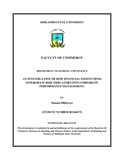Please use this identifier to cite or link to this item:
https://cris.library.msu.ac.zw//handle/11408/3062| Title: | An investigation of how financial institutions integrate risk indicators into corporate performance management. | Authors: | Dhliwayo, Pamela | Keywords: | Financial institutions Corporate performance management |
Issue Date: | 2016 | Publisher: | Midlands State University | Abstract: | This study was carried out to investigate on how financial institutions integrate risk indicators into their corporate performance management. The major objective of the study was to find out how financial institutions go about in identifying risk indicators for the various risks they are exposed to, who is responsible for the process of measuring and monitoring risks and how they report risk profiles and performance at the same time. The other objectives were to identify the various key risk indicators that banks are currently using and how they identify and select the most appropriate indicators. Other authors who have previously explored this area mainly looked at KRIs as an operational risk management tool, while others looked at how banks can use to KRIs to recover from the effects of financial turmoils like the subprime mortgage crisis of 2004 and the 2008 global financial crisis. A descriptive research design was followed with data gathered from primary sources using a questionnaire that was designed for both senior and junior management. The research also made use of secondary data sources like financial statements of various banks that were consulted as well as RBZ publications. Seven out of the eighteen banks that operate in Zimbabwe were used in the study. The findings of the study showed that most banks use KRIs for managing operational risk, they have not explored other risks yet. It was also discovered that senior management and the board of directors were responsible for policy formulations and most banks are still at preparatory stages interms of the incorporation of KRIs into a formally approved policy. The RBZ seem to be making strides in ensuring rigorous risk management systems and by so doing provide a basis that banks can use to develop sets of KRIs. Through its regular onsite risk-based supervisions provide a risk assessment system that provide each bank’s risk profile in relation to inherent risks. The RBZ also uses the CAMELS regulatory to assess the performance and risk exposure of banks. The study concluded that for any bank to benefit from using Key risk indicators there has to be an understanding of the risk factor in question. The reporting of KRIs is done mainly on a quarterly basis of which it is insufficient. It was also concluded that key risk indicators are closely related to key performance indicators and if a financial institution can properly monitor the two then it is possible to monitor risk and performance at the same time. | URI: | http://hdl.handle.net/11408/3062 |
| Appears in Collections: | Bachelor Of Commerce Banking And Finance Honours Degree |
Files in This Item:
| File | Description | Size | Format | |
|---|---|---|---|---|
| FIRST DRAFT.pdf | Full Text | 620.91 kB | Adobe PDF |  View/Open |
Page view(s)
132
checked on Feb 26, 2025
Download(s)
122
checked on Feb 26, 2025
Google ScholarTM
Check
Items in MSUIR are protected by copyright, with all rights reserved, unless otherwise indicated.


